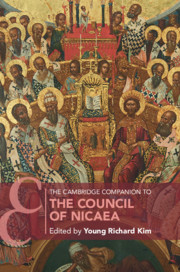Book contents
- The Cambridge Companion to the Council of Nicaea
- Cambridge Companions to Religion
- The Cambridge Companion to the Council of Nicaea
- Copyright page
- Dedication
- Contents
- Figures
- Contributors
- Acknowledgements
- Abbreviations
- 1 Introduction
- Part I Contexts
- Part II The Council
- Part III Outcomes
- Part IV The Aftermath
- Part V The Long Reception
- 15 The Legacy of the Council of Nicaea in the Orthodox Tradition
- 16 Catholic Reception of the Council of Nicaea
- Appendices
- Bibliography
- Index
- References
15 - The Legacy of the Council of Nicaea in the Orthodox Tradition
The Principle of Unchangeability and the Hermeneutic of Continuity
from Part V - The Long Reception
Published online by Cambridge University Press: 17 December 2020
- The Cambridge Companion to the Council of Nicaea
- Cambridge Companions to Religion
- The Cambridge Companion to the Council of Nicaea
- Copyright page
- Dedication
- Contents
- Figures
- Contributors
- Acknowledgements
- Abbreviations
- 1 Introduction
- Part I Contexts
- Part II The Council
- Part III Outcomes
- Part IV The Aftermath
- Part V The Long Reception
- 15 The Legacy of the Council of Nicaea in the Orthodox Tradition
- 16 Catholic Reception of the Council of Nicaea
- Appendices
- Bibliography
- Index
- References
Summary
The normative importance of the Council of Nicaea in the Orthodox tradition cannot be overestimated. A landmark event in cementing the authority of the Council of Nicaea was the Council of Constantinople (381). In the fifth century, Cyril of Alexandria was singularly concerned about promoting the Nicene Creed and making the interpretation of its second article a focal point in the Christological controversy. The Council of Ephesus (431) formulated the principle of unchangeability of the Nicene faith. The Council of Chalcedon (451) reaffirmed this principle and, building upon the precedent of the Council of Constantinople, advanced a hermeneutic of continuity with the Council of Nicaea. In the sixth century, the Nicene faith passed into the Byzantine liturgy in the form of the Constantinopolitan Creed rather than the original Nicene Creed. In addition, the role of the Council of Nicaea was safeguarded in the Orthodox Church’s liturgical memory through the feast days dedicated to different aspects of the council. The council also left a mark in hagiography and iconography. During the Filioque Controversy, the Nicene legacy, especially the Constantinopolitan Creed without the Filioque clause, was turned into a marker of a Byzantine Christian as opposed to Latin Christian identity.
Keywords
- Type
- Chapter
- Information
- The Cambridge Companion to the Council of Nicaea , pp. 327 - 346Publisher: Cambridge University PressPrint publication year: 2021
References
Select References
- 1
- Cited by



